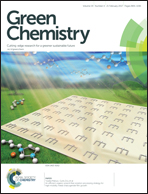Protic ionic liquid [Bim][NTf2] with strong hydrogen bond donating ability for highly efficient ammonia absorption†
Abstract
Cost-efficient and environmentally benign treatment of NH3-containing exhaust gas has been a challenge. Ionic liquids (ILs) due to their unique structures and properties are recognized as potential solvents to absorb NH3. In this study, three types of ILs, including [Bmim][NTf2], [Bim][NTf2], [HOOC(CH2)3mim][NTf2], were designed and synthesized with various hydrogen bond donating abilities and characterized based on their thermodynamic dissociation constants (pKa). The results showed that protic ionic liquid (PIL) [Bim][NTf2] with a moderate pKa value had the highest NH3 absorption capacity (up to 2.69 mol NH3 per mol IL, 313 K, 100 kPa). Experimental characterization and theoretical calculations verified that such extremely high NH3 absorption capacity for [Bim][NTf2] resulted from the interactions between H-3 on the imidazole ring and the NH3 molecule and NH3 molecules sintering themselves. Furthermore, stable absorption performance was recorded for [Bim][NTf2] over four cycles, implying potential applications in the industry for NH3 recycling.
![Graphical abstract: Protic ionic liquid [Bim][NTf2] with strong hydrogen bond donating ability for highly efficient ammonia absorption](/en/Image/Get?imageInfo.ImageType=GA&imageInfo.ImageIdentifier.ManuscriptID=C6GC03026B&imageInfo.ImageIdentifier.Year=2017)


 Please wait while we load your content...
Please wait while we load your content...